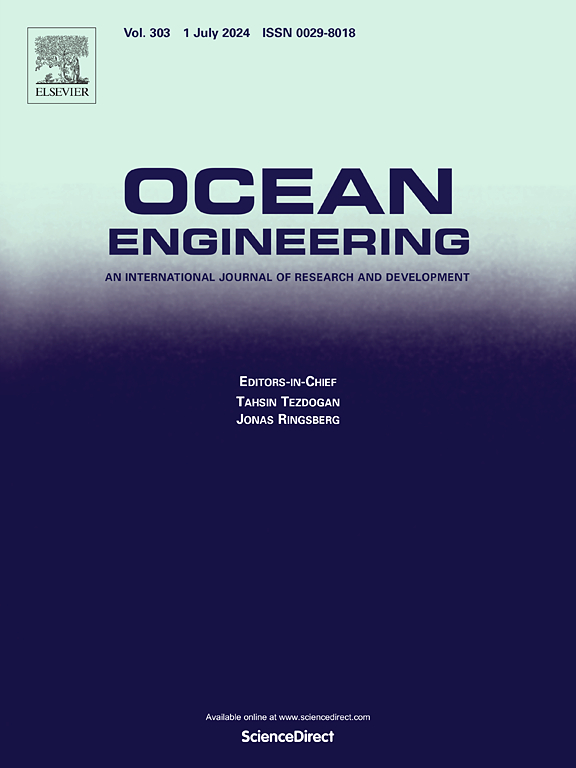破碎波中空气夹带机制和涡旋结构的数值研究
IF 5.5
2区 工程技术
Q1 ENGINEERING, CIVIL
引用次数: 0
摘要
破波是一种高度非线性、多尺度的气液现象,对船舶性能和船舶周围气泡流的预测具有重要意义。本研究采用基于自适应网格细化的高保真数值方法,结合CLSVOF界面捕获方法和Liutex-Omega涡识别技术,系统研究了三种具有代表性的破碎波类型:溢出型、弱下沉型和强下沉型。研究重点是对空气夹带机制进行分类和分析,表征气泡和液滴在不同阶段的体积、数量和大小分布等统计特性,揭示复杂涡结构的形成和演化。研究结果表明,下坠型破碎机具有射流夹带、后飞溅夹带、溅溅夹带、前缘夹带和湍流夹带等多种气流夹带形式,而溢流型破碎机仅包含后两种气流夹带机制。液滴大小服从幂律分布,指数约为- 4.5,气泡大小服从幂律- 10/3。强力俯冲型破浪产生的液滴和气泡明显多于其他类型。射流冲击夹带通过旋转变形产生展向涡管和流向环状涡,而飞溅冲击和前缘夹带产生类似于湍流边界层中观察到的发夹涡。与湍流夹带有关的涡旋表现出广泛的空间覆盖和相对较弱的强度。这项工作不仅提供了系统的卷带和涡旋动力学特征,而且提供了广泛的气泡和液滴定量数据集,为开发基于物理的船舶诱导气泡流的气泡模型提供了有价值的参考。本文章由计算机程序翻译,如有差异,请以英文原文为准。
Numerical study of air entrainment mechanisms and vortical structures in breaking waves
Wave breaking is a highly nonlinear, multi-scale gas–liquid phenomenon with critical implications for ship performance and the prediction of bubbly flows around vessels. This study employs a high-fidelity numerical approach based on adaptive mesh refinement, combining the CLSVOF interface-capturing method with the Liutex-Omega vortex identification technique, to systematically investigate three representative types of breaking waves: spilling, weak plunging, and strong plunging breakers. The research focuses on classifying and analyzing air entrainment mechanisms, characterizing the statistical properties of bubbles and droplets, which include volume, number, and size distribution, across different stages, and revealing the formation and evolution of complex vortex structures. The results show that plunging breakers exhibit multiple air entrainment types, including jet-impact entrainment, backward-splash entrainment, splash-impact entrainment, leading-edge entrainment, and turbulent entrainment, while spilling breakers involve only the latter two mechanisms. Droplet sizes follow a power-law distribution with an exponent of approximately −4.5, and bubble sizes conform to a −10/3 power law. Strong plunging breakers generate significantly more droplets and bubbles than the other types. Jet-impact entrainment induces spanwise vortex tubes and streamwise ring-like vortices through rotational deformation, while splash-impact and leading-edge entrainment generate hairpin vortices analogous to those observed in turbulent boundary layers. Vortices associated with turbulent entrainment exhibit wide spatial coverage and relatively weak intensities. This work not only provides a systematic characterization of entrainment and vortex dynamics but also delivers extensive quantitative datasets of bubbles and droplets, offering valuable references for developing physics-based bubble models for ship-induced bubbly flows.
求助全文
通过发布文献求助,成功后即可免费获取论文全文。
去求助
来源期刊

Ocean Engineering
工程技术-工程:大洋
CiteScore
7.30
自引率
34.00%
发文量
2379
审稿时长
8.1 months
期刊介绍:
Ocean Engineering provides a medium for the publication of original research and development work in the field of ocean engineering. Ocean Engineering seeks papers in the following topics.
 求助内容:
求助内容: 应助结果提醒方式:
应助结果提醒方式:


